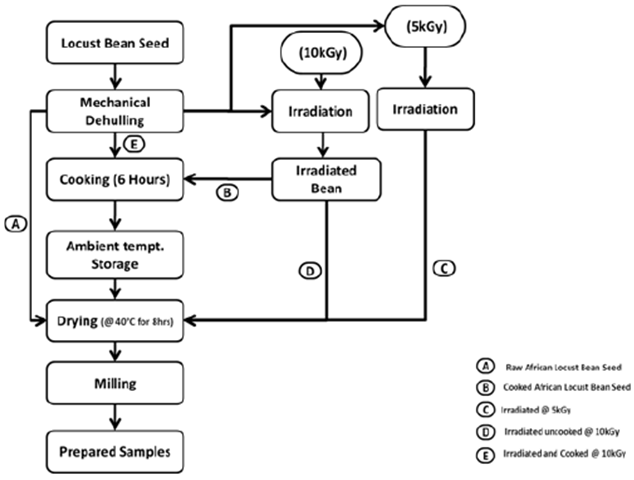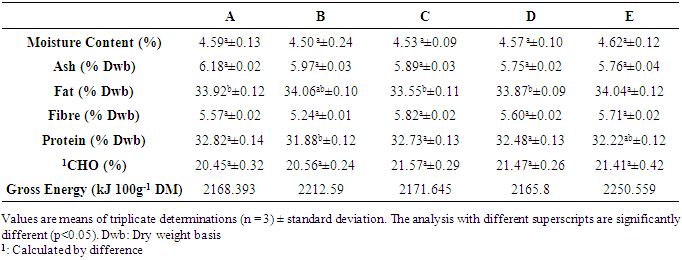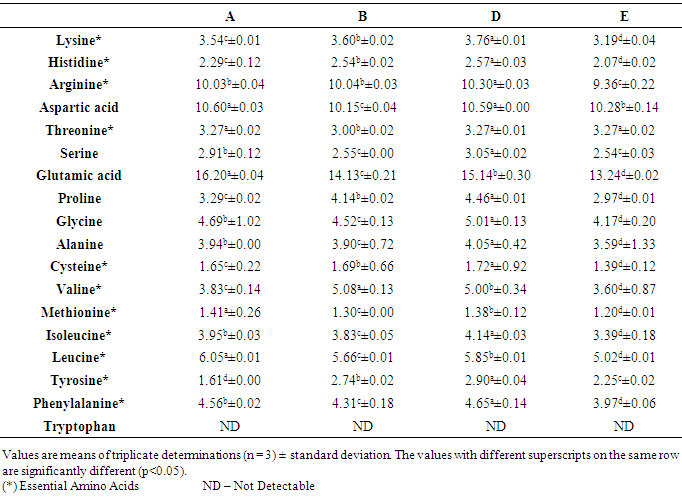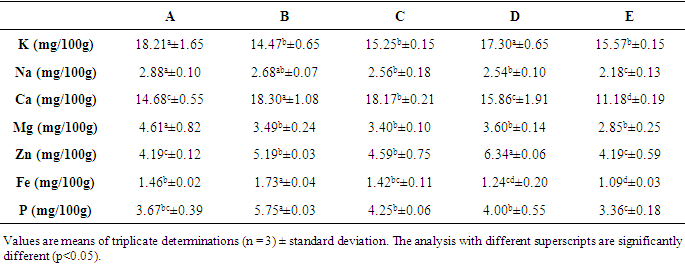-
Paper Information
- Paper Submission
-
Journal Information
- About This Journal
- Editorial Board
- Current Issue
- Archive
- Author Guidelines
- Contact Us
Food and Public Health
p-ISSN: 2162-9412 e-ISSN: 2162-8440
2016; 6(1): 8-14
doi:10.5923/j.fph.20160601.02

Effects of Gamma Irradiation and Cooking on the Physico-Chemical Properties of African Locust Bean (Pakia biglobosa) Seeds
Solomon Abey1, Nosarieme Omoregie Abey2
1School of Agriculture and Agricultural Technology, Federal University of Technology Akure, Osogbo
2School of Science, Federal University of Technology, Akure, Department of Biochemistry
Correspondence to: Solomon Abey, School of Agriculture and Agricultural Technology, Federal University of Technology Akure, Osogbo.
| Email: |  |
Copyright © 2016 Scientific & Academic Publishing. All Rights Reserved.
This work is licensed under the Creative Commons Attribution International License (CC BY).
http://creativecommons.org/licenses/by/4.0/

African locust bean (Pakiabiglobosa) is a rich source of plant protein and vitamin substitutes. Combination of Irradiation and cooking has been found to effect various changes in the physical, chemical and functional properties of foods. This study evaluates the effect of cooking, Gamma irradiation (cobalt-60) and Post-irradiation cooking on the physicochemical properties of African Locust Bean (Pakiabiglobosa) seed and its oil extract. Some of bean seed were treated with different doses of gamma rays (0, 5 and 10kGy) as irradiated samples, some were boiled as cooked samples while others were boiled and irradiated, unirradiated-uncooked seed serve as control samples. The proximate chemical analysis, Mineral analysis, the analysis of functional properties and the determination of anti-nutritional factors were carried out appropriately to evaluate the physicochemical effects of cooking and irradiation. The fat content significantly increased after cooking and post-irradiation by 0.4 and 0.35% respectively. There was a 3.84% increase in mineral content after cooking, 2.37% increase on post-irradiation (10kGy) but a loss in total mineral content of irradiated-cooked samples. 10kGy irradiated-uncooked samples increased the essential amino acid. The functional properties of the seeds were negatively affected by irradiation and cooking. The antinutrients were significantly reduced by cooking, irradiation and post-irradiation cooking by 60%, 40% and 60% respectively. From the result, the cooked and irradiated samples had an overall improved physicochemical properties compared to the control unlike the irradiated-cooked. This study therefore emphasizes the effect of the various method of preservation on the physicochemical properties of the locust beans establishing the fact that a combined method of preservation will set imbalance in the food properties (African locust bean).
Keywords: African locust bean, Irradiation, Cooking, Physico-Chemical properties, Amino acid, Functional properties
Cite this paper: Solomon Abey, Nosarieme Omoregie Abey, Effects of Gamma Irradiation and Cooking on the Physico-Chemical Properties of African Locust Bean (Pakia biglobosa) Seeds, Food and Public Health, Vol. 6 No. 1, 2016, pp. 8-14. doi: 10.5923/j.fph.20160601.02.
1. Introduction
- Rural dwellers in developing countries like Nigeria consume African locust bean in search for plant protein, this has made Pakia biglobosa to find popular use especially in the fermented dawadawa form which is a product of the African locust bean [1]. The nutritional components of this legume can be marred or enhanced by processing technologies such as cooking and irradiation. Food processing involves the changing of raw food into other forms that are more palatable by physical or chemical means. Cooking is an aged thermal method of processing food which has long been employed for food processing. Irradiation is a method of processing food which is now commercialized [2] and it has become effective means of processing and preserving food products which involves administration of measured doses of the radiant energy that are product specific. The irradiation process involves exposing the food, either prepackaged or in bulk, to a predetermined level of ionizing radiation. Ionizing radiation interacts with an irradiated material and ionizes molecules by creating positive and negative ions through energy transference in the electron. The effects of these processing technologies on the chemical and functional properties of food has been of great concern which triggers the urgent need for the evaluation of the side effects of these common processing methods on foods especially African diet. This study therefore seeks to evaluate the effect of cooking and irradiation on the physico-chemical properties of African Locust Bean (Parkia biglobosa), by determining the effect of medium doze gamma irradiation and examining the effects of cooking and post-irradiation cooking on the physico-chemical properties, chemical composition and functional property of the African Locust Bean.
2. Materials and Methods
- Wholesome African locust bean seeds (Pakia biglobosa) were obtained from the local market at Oja Oba, Akure, Ondo State of Nigeria.All the chemicals and reagents used in the study were of analytical grade.Seed Preparation
 Irradiation The raw grains were treated with gamma rays at doses of 0, 5 and 10 kGy. Multipurpose gamma irradiator with a Cobalt60 source was used (compact-type commercial radiator) at the Sheda Science and Technology Complex (SHESTCO), Abuja, Nigeria.Cooking The cooked samples were boiled for 6 hours in distilled water in the proportion of 1:3. After cooking, the samples were placed in aluminum trays and dried with forced circulation of air at 50–55°C until constant weight (approximately 24 h).Chemical Analysis Proximate chemical composition Quantitative composition was determined on each of the samples using the following analytical methods: Moisture content according to method 964.22 of AOAC [3]; crude protein according to method 955.04 of AOAC [3]; crude fat extracted overnight in a Soxhlet extractor with hexane and quantified gravimetrically; ash according to method 923.03 of AOAC [3]; The gross energy was calculated based on the formula used by Ekanayake [4].Mineral analysis Analysis of sodium and potassium content of the samples was carried out using flame photometry, while phosphorus was determined by the phosphovanado-molybdate (yellow) method [3].Determination of anti-nutritional factors The method of Wheeler [5] as modified by Reddy [6] was used for phytic acid and phytate-phosphorus determinations. Tannin contents were determined by the modified vanillin-HCl method [7] [8]. Determination of oxalate was by the AOAC method [3].Analysis of Functional Properties The following functional properties will be determined in the samples: water and oil absorption capacities, least gelation concentration, foaming and emulsifying capacities. The determination of water and oil absorption capacities followed a modification of the method of Prinyawiwatkul [9]. The foaming properties of the samples were determined using the procedure of Coffmann [10]. Emulsifying properties were determined using a modification of the method described by Ige [11].Statistical Analysis Data collected from the study were subjected to analysis of variance (ANOVA) as described by Snedecor [12]. Differences among means were separated using Duncan’s multiple range test [13]; significances were accepted at 5% level (P ≥ 0.05). The statistical software used was SPSS 16.0 for windows.
Irradiation The raw grains were treated with gamma rays at doses of 0, 5 and 10 kGy. Multipurpose gamma irradiator with a Cobalt60 source was used (compact-type commercial radiator) at the Sheda Science and Technology Complex (SHESTCO), Abuja, Nigeria.Cooking The cooked samples were boiled for 6 hours in distilled water in the proportion of 1:3. After cooking, the samples were placed in aluminum trays and dried with forced circulation of air at 50–55°C until constant weight (approximately 24 h).Chemical Analysis Proximate chemical composition Quantitative composition was determined on each of the samples using the following analytical methods: Moisture content according to method 964.22 of AOAC [3]; crude protein according to method 955.04 of AOAC [3]; crude fat extracted overnight in a Soxhlet extractor with hexane and quantified gravimetrically; ash according to method 923.03 of AOAC [3]; The gross energy was calculated based on the formula used by Ekanayake [4].Mineral analysis Analysis of sodium and potassium content of the samples was carried out using flame photometry, while phosphorus was determined by the phosphovanado-molybdate (yellow) method [3].Determination of anti-nutritional factors The method of Wheeler [5] as modified by Reddy [6] was used for phytic acid and phytate-phosphorus determinations. Tannin contents were determined by the modified vanillin-HCl method [7] [8]. Determination of oxalate was by the AOAC method [3].Analysis of Functional Properties The following functional properties will be determined in the samples: water and oil absorption capacities, least gelation concentration, foaming and emulsifying capacities. The determination of water and oil absorption capacities followed a modification of the method of Prinyawiwatkul [9]. The foaming properties of the samples were determined using the procedure of Coffmann [10]. Emulsifying properties were determined using a modification of the method described by Ige [11].Statistical Analysis Data collected from the study were subjected to analysis of variance (ANOVA) as described by Snedecor [12]. Differences among means were separated using Duncan’s multiple range test [13]; significances were accepted at 5% level (P ≥ 0.05). The statistical software used was SPSS 16.0 for windows.3. Results
|
|
|
|
 | Table 5. Effect of various treatments on the functional properties of African Locust Bean Seed (Pakia biglobosa) |
 | Table 6. Effect of various treatments on some of the Antinutritional constituents of African Locust Bean Seed (Pakia biglobosa) |
4. Discussion
- Cooking led to loss of moisture although not significant and consequently, to a significantly increase in fat contents (P < 0.05) among treatments. Badiani [14] reported that most nutrients increased their concentration as a consequence of moisture loss through cooking. The values of total lipids obtained in this study for the raw African locust bean seed conforms to that obtained by Omafuvbe [15], Oladunmoye [16] and Gernah [1]. However, this results support the fact generally accepted that total moisture content decreases as fat content increases [17]. There was no significant effect of gamma irradiation on the proximate composition of the seed (Table 1) except for the increased fat content observed in the post-irradiated cooked sample which can be explained to have resulted from the rupture of the oil cell in the seed skin during cooking accounting for the increased oil content. A significant reduction of 2.9% in protein content was observed when the seed was cooked. The irradiation procedure did not significantly influence the reduction of the tannin hence there was no resultant effect on the protein content as tannins usually form insoluble complexes with proteins, thereby interfering with their bioavailability. This study indicated a high ash content value for African Locust bean seed of about 6.18% as against 5.4% reported by [15] and 4.47% reported by [16]. These variations may be due to genetic diversity of the African Locust bean as well as varying cultivars.Potassium appeared the highest occurring mineral in the African locust Bean Sample which account for 36.7% of the total mineral. This aligns with value obtained by Enujiugha [18] and Oladunmoye [16]. On the other hand, Dashak [19] identified various cultivars of the African Locust Bean seed and reported that Calcium was highest in two out of the three Locust beans they examined. There was an observed increase in iron and potassium upon cooking indicating the inactivation of antinutrients (which binds to metals and other minerals). Sodium was lost in the cooked as well as post-irradiated cooked samples significantly and this is probably due to its solubility and its ability to leach-off through cooking water. It can however be observed that mineral bioavailability can be increased with cooking with little impact on the mineral constituent of the seed as shown (Table 3). There was a 3.8% total mineral increase in the cooked seed compared to about 2.4% increase observed in the 10kGy irradiated sample. Post-irradiation cooking incurred a significant loss of about 18.7% of the total mineral and this might have resulted from the dissolution of the soluble minerals into the cooking water. Zinc was significantly increased in cooked as well as 10kGy irradiated samples. This mineral acts as a stabilizer of the structures of membranes and cellular components.There was an observed significant increase in the Lysine content of 10kGy irradiated African Locust bean seed sample (Table 2), this increase is similar to the result obtained by Bhat [20], when lotus seed was irradiated with electron beam irradiation, though, at a higher dose of 30kGy. The Acidic Amino acids were the highest amino acids in the African locust bean seed Sample accounting for approximately 32% (12.7% and 19.3% for Aspartic acid and Glutamic acid respectively) of the entire amino acid profile of the seed (TAAA, Table 4). The total essential amino acid upon post-irradiation cooking incurred a 9.8% loss. This might have resulted from the synergistic effect of both irradiation and cooking on the depletion of the amino acid, via the desulphurisation and denaturation of amino acid proteins. PER was highest in the raw sample with the post-irradiated cooked sample having the lowest. The PER of 10kGy irradiated sample is tolerable.Water Absorption Capacity (WAC) is important functional property for flours as they swell and impart characteristics like body thickness and viscosity. There was a significant decline in the water absorption capacities of both the raw cooked sample as well as the irradiated cooked sample (Table 5). Rhama [21] reported similar observations with irradiated peanut. There was no significant change in the 10kGy irradiated sample although there was a reduction in the WAC of the 5kGy irradiated sample. The reduction in the WAC as a result of irradiation might be due to the counteracting effects of irradiation on protein and starch components present in African locust bean seed flour. These components both have a potential affinity for water [22]; [23]. On one hand, irradiation-induced unfolding and the ensuing exposure of non-polar protein sites may have led to a reduction in the availability of polar amino groups for water binding [24] [25] resulting in decreased WAC. Cooking led to increase in oil absorption capacity of the seed flour. Dissociation and denaturation results in the increased oil and water absorption of treated proteins compared to native proteins [26]. Radiation processing may have resulted in protein unfolding leading to exposure of certain buried functional groups resulting in increased oil absorption capacity. Results show that cooking significantly increased the Oil Absorption Capacity (OAC) of the seed flour. Thus suggesting that heat treatment leads to increased OAC. Sosulski [27] reported similar observations with sunflower. Increased oil absorption capacity might result from the dissociation and denaturation of proteins by heat [28]. Cooking significantly reduced the Foaming Capacity (FC) by about 92.6%. This finding aligns with reports by Rahma [21] and Yusuf [29]. Irradiation caused a significant decrease in FC at 5kGy and 10kGy. The decreases in FC may be related to protein denaturation and protein–protein crosslinking. However, given the FC values recorded in the present study, African locust bean seed flour has it foaming capacity compromised by all the treatment. The 5kGy irradiated sample has the highest foam stability while the cooked sample has the lowest foam stability. There was no significant reduction in the Least Gelation Concentration LGC of the raw-cooked sample. There was a significant reduction in the LGC of the post-irradiated cooked sample of about 75%. Low LGC means better gelation property. Protein gelation is vital in the preparation and acceptability of many foods, including vegetable and other products. Significant reduction in LGC was seen at 5kGy gamma irradiation dose (p < 0.05). Such a decrease in LGC might be attributed to increased interaction of proteins with water. Cooking significantly reduced the Emulsion Capacity (EC) of the African locust bean seed flour by 5.3%. Concentration dependent emulsifying activity has been explained based on adsorption kinetics [30]. Irradiation at 5kGy and 10kGy yield a significant decrease in the emulsion capacity of the seed flour accounting for more than 10% loss of emulsion capacity. The decrease in EC has been speculated to have resulted from changes, such as protein aggregation as well as surface hydrophobicity and charge characteristics [31]. Comparing the different treatment methods, cooking and post-irradiation cooking are to be preferred to irradiation alone in order to keep oxalate intake as low as possible. Although cooking alone showed no significant difference from post irradiated cooked sample (Table 6). Observations were comparable to the study reports of others [32] [33]. Oxalate can have deleterious effects on human nutrition and health, particularly by decreasing calcium absorption and aiding the formation of kidney stones [34]. Result obtained indicates that Phytate content was partially decreased with the cooking treatments. Among the treatments irradiation appeared effective to reduce the phytate level in this oil seed, which could reduce 4.8% of phytate compared to control sample. However, cooking has been reported to lower the phytate levels in several plant foodstuffs [6] [35]. It could also be due to the dephosphorylation of phytate which is a prerequisite for improving nutritional value. This results in increased bioavailability of essential dietary minerals. Irradiation reduction of tannin might have resulted into significant increase in Zinc content at 10kGy irradiation dose.
5. Conclusions
- The African locust bean seed has demonstrated its nutritional adequacy as an oil seed and a rich mineral-protein source capable of combating protein malnutrition in sub-Saharan Africa, its utilization as soup making condiment has been largely exploited in the rural communities of West Africa. Irradiation reduces the potency of antinutritional factors that are capable of reducing the bioavailability of micronutrients which are the essentials needed for sustenance and wellbeing of trace functions within the body and are responsible for health balance. Post-irradiation cooking caused a significant reduction in the total essential amino acid, however, since utilization of African Locust bean seed requires fermentation into soup condiments this loss can be replenished via the enzymatic release of essential nutrients. Trace quantities of antinutritional factors not significantly reduced upon post-irradiation cooking aligns with epidemiological relevance which has shown that low level polyphenolic compounds possess rich antioxidant properties and are effective in reducing cardio-cerebrovascular diseases and cancer mortality. Irradiation and Post-irradiation cooking however can be concluded viable for the treatment of African Locust bean (Parkia biglobosa) seed as it effectively enhance the nutritional component of the oil seed by inactivating antinutrients and allowing bioavailability of minerals needed for body development.
 Abstract
Abstract Reference
Reference Full-Text PDF
Full-Text PDF Full-text HTML
Full-text HTML


